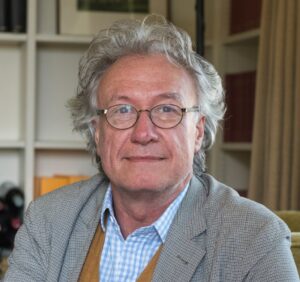
Physiology News Magazine
President’s View:
A hive of activity highlighting the value of physiology and creating new opportunities at The Society
News and Views
President’s View:
A hive of activity highlighting the value of physiology and creating new opportunities at The Society
News and Views

https://doi.org/10.36866/pn.126.6
Professor David Paterson
President, The Physiological Society
In April we welcomed physiologists from across the world to our first in-person scientific conference since the start of COVID-19 pandemic. Biomedical Basis of the Elite Performance (BBEP) in Nottingham, UK was a vibrant display of the very best aspects of our conferences – discussing fantastic science while catching up with colleagues old and new (more on p.32).
Some key highlights from the meeting include:
179 attendees from 11 countries
20 invited speaker talks and lectures
6 oral communications
56 posters
Our online meetings have been really popular during the pandemic, and we intend to continue online events as part of our programme, but BBEP showed to me the real value in meeting together face to face. I’m looking forward to Sensory Signals in London, UK in June and Europhysiology in Copenhagen, Denmark in September.
Following a project last year focused on considering how the UK’s research ecosystem should best recognise and foster interdisciplinary research, we have been working with Research England to feed into their plans for the ‘next REF’. As many Society members will be aware, REF outcomes are used to inform the allocation of around £2 billion per year of public funding for universities’ research. The ‘Future Research Assessment Programme’ (FRAP) was launched by the UK’s higher education funding bodies in May 2021 and aims to explore possible approaches to the assessment of UK higher education research performance. A future exercise will continue to enable the funding bodies to allocate funding based on research quality and will continue to provide accountability for public investment in research.
The Society convened a high-level roundtable with Research England to discuss some of the key issues and concerns facing physiologists with the REF process. Topics covered included the cost/benefit of REF, the pros and cons of a metric-driven approach, and REF’s sometimes negative impact on research culture. As physiologists, we were also particularly concerned that the current system often results in our discipline falling between the cracks, and therefore we discussed how the ‘next REF’ could better support disciplines like ours. Research England is currently considering responses to their consultation and will report back in the autumn.
The Society also recently held a workshop with the Biotechnology and Biological Sciences Research Council (BBSRC) to launch a report resulting from a project I chaired with BBSRC reviewing the opinions of researchers into the use of models in research. This is a complex area involving a range of experimental systems spanning the remit of in vitro, in silico and in vivo techniques to better understand biological processes.
As physiologists, we are engaged in many different areas of research into cell, tissue, organ, and system function (and malfunction), using various different experimental approaches. One key question for our study design must be “am I using the correct model for my research question?” With a plethora of animal models, in vitro experiments, and the growing use of in silico modelling, this choice is fundamental to ensure that the data produced are relevant (more on p.9).
The project aimed to understand the current use of experimental systems or models for human and animal research. It has also looked into how researchers perceive the future of animal models. The report is available on BBSRC’s website (1).
In June I am looking forward to an event The Society is holding in Parliament to celebrate the role of physiology in teaching. The event will launch a new report from The Society and The Academy For Healthcare Science. This is based on an independent economic analysis by economists Emsi, which shows that the impact of graduates who studied courses with a core physiology component is over £22 billion a year to the UK economy. I’m looking forward to reading more in the report, which will be available on our website.
Finally, I am pleased to let you know that at our Board meeting in March we agreed to create a new role for a clinical Trustee. We saw during the COVID-19 pandemic the vital contribution of physiologists across academia and clinical settings working together, and The Society has well-established links with organisations such as the Intensive Care Society. We are now looking to go further by ensuring clinicians have a direct voice in The Society as a Trustee. This will build on work such as our “Questions from the Frontline” initiative and ensure The Society is representing the breadth and depth of the discipline.
This drive will be reinforced at our 2022 President’s Lecture event in early December, where I am delighted to announce that the recipient of the 2022 President’s Lecture Medal will be Sir Patrick Vallance. Sir Vallance spearheaded the UK’s response to the pandemic and is an Honorary Fellow of The Society. More information about the event will be available soon.
From getting back to in-person conferences, engaging with BBSRC and Research England on the R&D landscape and our renewed focus on clinical physiology, this is a really exciting time for The Society. I look forward to seeing you soon at one of our events – keep an eye on our website for all the details.
References
1 www.ukri.org/publications/bbsrc-survey-report-on-the-use-of-models-in-research
